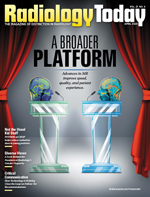 Women’s Imaging: Early Warning
Women’s Imaging: Early Warning
By Meghan Musser, DO
Radiology Today
Vol. 21 No. 4 P. 6
AI helps detect the most challenging breast cancers.
Breast cancer detection has improved significantly in recent years due to advancements in screening technology and techniques, such as digital breast tomosynthesis (DBT). DBT offers a number of benefits to patients, such as improved cancer detection with fewer false-positives and unnecessary recalls, but it yields an exponential increase of images compared with traditional full-field digital mammography (FFDM). While DBT provides clinicians with more data than ever, analyzing this newfound wealth of information can increase the daily workload for radiologists by almost two-fold and lead to reader fatigue and burnout, which may ultimately impact patient care.1
The power of AI has recently been harnessed to address this emerging challenge, as DBT rapidly grows in adoption. AI is clinically proven to help doctors detect cancers earlier, when they may be more easily treated, while reducing the rate of false-positives and unnecessary recalls, which can be stressful for patients. It also helps doctors read DBT cases faster and more accurately—even with the most challenging cases, such as those with dense breasts or invasive lobular carcinomas (ILC).
Although it is the second most common type of breast cancer, the radiologic diagnosis of ILC can be uniquely challenging for radiologists.2 It can present in patients without ever forming a palpable lesion and, on mammographic images, ILC lesions often appear to have a density equal to or less than that of normal fibroglandular tissue.
Not only is ILC one of the most elusive types of breast cancers to detect, but it also can be among the most difficult to treat. ILC can metastasize to common sites, such as the bones, lungs, brain, and liver, but it can also spread to unusual sites, such as the peritoneum-retroperitoneum, gastrointestinal tract, urogenital tract, leptomeninges, and myocardium. Additionally, ILC tends to be associated with a higher rate of multiplicity and bilaterality than other types of invasive carcinomas. It is one of the cancers that radiologists fear the most, but new AI technology offers a solution that is providing physicians and their patients with a new defense against even the most difficult-to-detect lesions.
The Advent of AI
In 2018, the FDA-cleared ProFound AI for DBT, an AI-based software that enhances breast cancer screening, even in challenging cases, such as in women with dense breasts or ILC. The technology is also CE Marked, Health Canada licensed, and available for 2D FFDM.
Intended to be used by radiologists reviewing mammography or DBT images, this software uses AI and pattern recognition technology to analyze each individual image, or slice, and identify potentially malignant lesions. Trained with one of the largest available image data sets, it provides radiologists with crucial information, such as Certainty of Finding and Case Scores, which represent the algorithm’s confidence in whether a lesion is malignant.
This AI technology was clinically proven in a large reader study to improve radiologist sensitivity by 8%, reduce unnecessary patient recall rates by 7.2%, and cut reading time for radiologists by 52.7%.3 Additionally, it cut reading time by up to 57.4% for radiologists reading cases involving dense breasts.1
Breast cancer screening remains crucial in the detection and management of ILC and other types of breast cancer. Current imaging modalities, such as DBT, ultrasonography, and MRI also play important roles, with each modality offering its own set of advantages and limitations. The use of AI complements breast cancer detection with DBT, addresses emerging workflow challenges for radiologists as breast cancer screening evolves, and assists physicians in detecting cancers earlier, when they may be more easily treated.
— Meghan Musser, DO, is a board-certified radiologist with an interest in women’s imaging. She is a member of the American Osteopathic College of Radiology, RSNA, the ACR, the American Roentgen Ray Society, and the American Osteopathic Association. She has been with Kettering Network Radiologists, Inc, since 2016.
References
1. Hoffmeister J. Artificial intelligence for digital breast tomosynthesis — reader study results (white paper). iCAD website. https://www.icadmed.com/assets/dmm253-reader-studies-results-rev-a.pdf. Published 2018.
2. Lopez JK, Bassett LW. Invasive lobular carcinoma of the breast: spectrum of mammographic, US, and MR imaging findings. Radiographics. 2009;29(1):165-176.
3. Conant EF, Toledano AY, Periaswamy S, et al. Improving accuracy and efficiency with concurrent use of artificial intelligence for digital breast tomosynthesis. Radiol Artif Intell. 2019;1(4):e180096.

